Winner of the 2023 WLA Student Awards – Award of Excellence in the Concept – Large Design category
Experienced the opposite settings of fallen trees in Hong Kong (urban city) and deadwood on Observatory Hill (forest) in Charlottesville, acknowledging the misconception of deadwood being perceived as destructive, the project aims to redefine decomposition as a joyful process and refine the general impression people have to deadwood. People are invited to witness the death of trees, to see, to touch, and to engage with this slow, quiet, yet elegant process. The design manipulates landforms, materials, and employs a simple visualization strategy to encourage interaction between humans and deadwood at Observatory Hill, aiming to reconnect people with the value of deadwood and recognize the ecological services contributed by decaying trees.
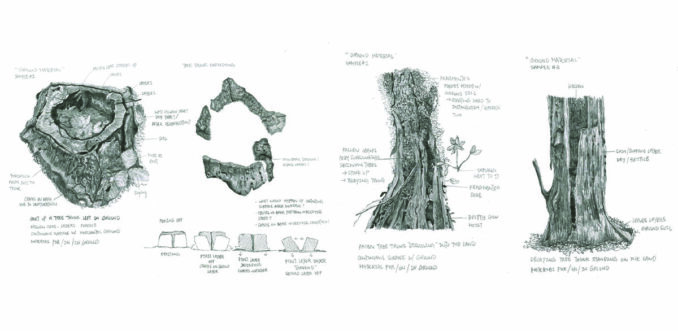
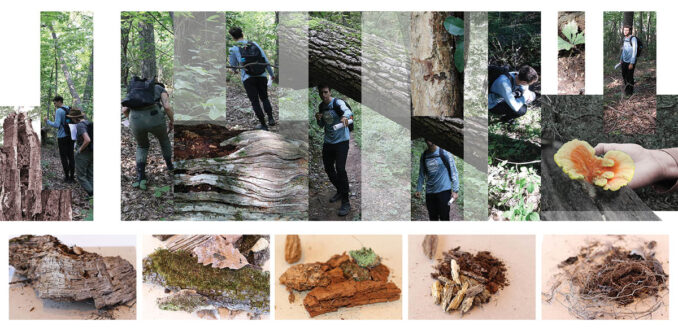
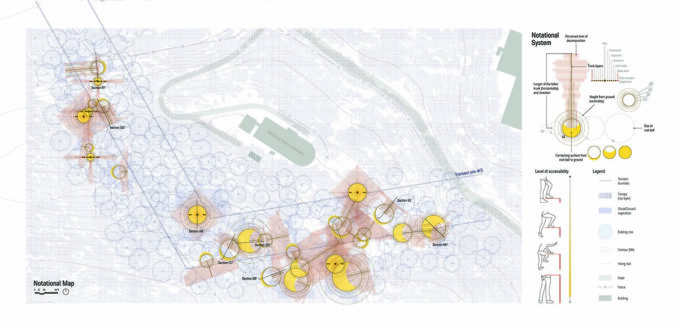
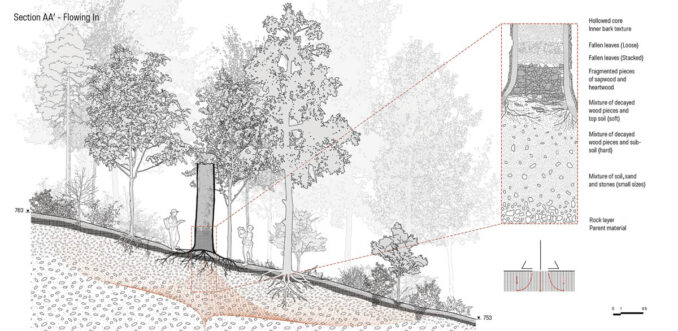
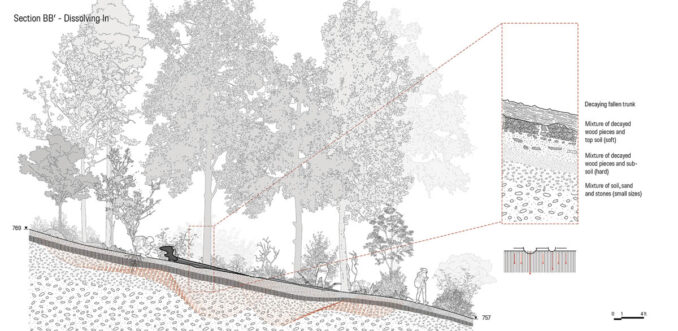
Reveal: Opening to the External World
Observatory Hill, once a material-sourcing forest for the university, now serves as a staging area for composting fallen trees and leaf matter from the campus. It supports research and recreational activities too. Thick layers of fallen leaves accumulated and piled up around. As I shuffled through, the satisfying crackle and soft, fluffy texture of the leaves caught my attention. Fungi and moss thrived among the standing snags and fallen wood. Despite their hollow and fragmented state, they maintained distinctive shapes and sprouted new leaves and twigs. It was an appealing journey. Revealing this connection and engaging with deadwood in a joyful manner is a key aspect of the design approach.
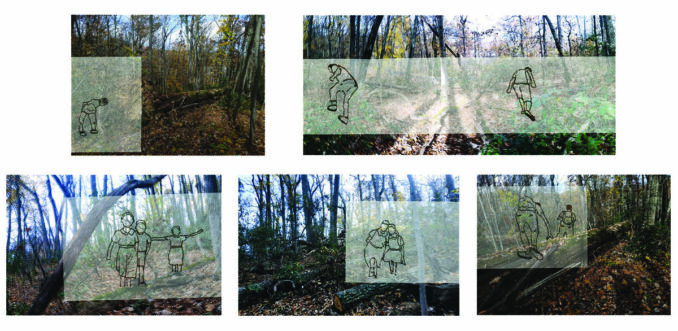
Assemble: Channeling Through Space and Time
Through experiential perspective, the scale of attention was manipulated to immerse people in the process of decomposition. Engagement should involve all senses, allowing a deeper understanding of the minute transformations within the microcosm. To enable this, a matrix of gradients representing decay intensity and deadwood density was created. This design enhances the moments of decomposition in both space and time. An in-person journey could rekindle a mutual relationship between humans and deadwood by experiencing the magnified process of decomposition.
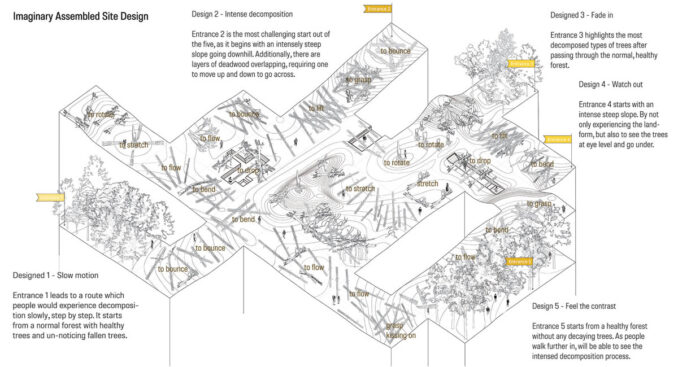
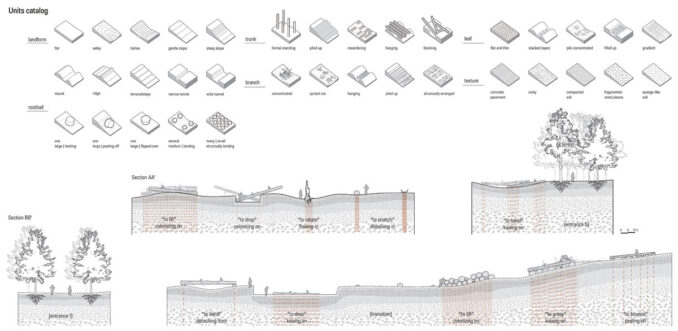
Entangle: Motions in the Unseen Microcosm
In an urban setting bounded by concrete slabs and bustling streets, the deadwood is being perceived as a threat. While in the forest, they are the cradles of ecosystem diversity. By adding in the ecological layer to the design and correlating human experience, the multispecies interactions seek to create a platform for people to conceive decomposition as a productive process. This is a process of dissolving, shifting, contributing, donating, returning, and creating. All the tissues disintegrate and become part of the other living systems.

Inscribe: Wayfinding in the Deadwood Wonderland
To refine decomposition and change the perception of deadwood through landscape design, key methods include introducing landforms, rearranging materials, and using a simple visualization strategy. Three landforms in different shapes and sizes are proposed to accommodate various group sizes and serve social and ecological functions. Painting the deadwood and landforms in bright red allows visitors to explore the dynamic nature of decomposition freely, rather than following a fixed path. Over time, the fading paint visualizes the material shift as the wood decomposes. Besides recreation, the site functions as a soil incubation center, producing high-quality soil. The landforms are designed to hold woody debris and control surface runoff, speeding up decomposition. Visitors are encouraged to interact with the deadwood like decomposers, touching, stepping, kicking, and playing to accelerate the process in this decomposition wonderland. It is a circle of life – it grows, decays, and is reborn.
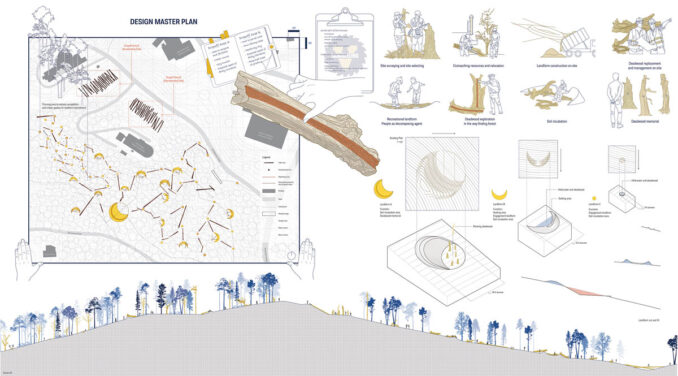
Re(de)fining Decomposition
Student: Joyce Fong, University of Virginia
Advisor: Leena Cho, Associate Professor, Department of Landscape Architecture, University of Virginia
